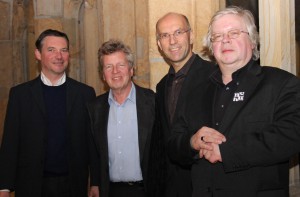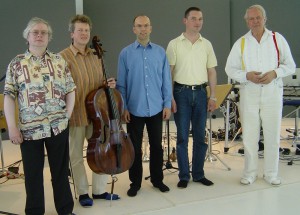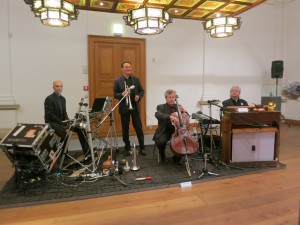In 1968, composer Karlheinz Stockhausen discovered a method of composition he was to call intuitive music. For a score he offers the musicians only a text as a direction. The freedom implied here may seem to allow random interpretation by the performers, but randomness was far from Stockhausen’s mind. He once said that he was not seeking indeterminacy, but an “intuitive determinacy” which would create the music. Stockhausen’s intuitive music thus became the formative inspiration for the Ensemble für Intuitive Music Weimar, which was founded in 1980.
During the time of the German Democratic Republic (East Germany), the musicians of the ensemble felt compelled to explore officially tabooed and “useless” areas of musical expression. The group’s activities began in an unlawful gallery in Erfurt, continued in numerous churches, and even rose to performance in the Palace of the Republic in Berlin. The listeners of pre-unification communist half of Germany, whose longing and curiosity were almost unappeasable, followed these excursions enthusiastically. Prior to the political change in 1989 several hundred concerts including Stockhausen’s music were given by EFIM. Since then the ensemble has performed in more then twenty-five countries in America, Europe and Asia.
In 1990, only after the border opening, did the ensemble give its first concert in the presence of Stockhausen. He wrote afterwards in a letter: “…it was good that I finally heard you in a concert. I would like to thank you all: you kept the intuitive music alive. We will surely go on together to develop this unfamiliar music form.” Following an intensive rehearsal phase in May 1991 he wrote: “THANKS for these Whitsun-days: also for me they were extraordinarily instructive, and you are simply four angels! I will help you, whenever I get a chance, to continue in the discovery and clarification of the intuitive music.” This fruitful collaboration culminated in 2005 in studio recordings of six intuitive compositions from the cycle Für kommende Zeiten under Stockhausen’s direction for his CD label.
Through EFIM’s characteristic interrelationship between orchestral instruments (trumpet/flügelhorn, violoncello, and piano/organ) and live-electronics, not only do an abundance of new sound structures develop, but some hardly conceivable communication processes are initiated as well. Electronics technology is viewed by the members of EFIM as a central component of instrumental discourse, rather than as a mere supplemental accessory. The computer-as-mobile-studio is thereby played as a musical instrument; one which can, through the use of multichannel sound diffusion systems, control the movement of sounds in space.
Beginning in 1987 a series of synesthetic projects based on Bauhaus traditions were realized. Since the early 1990s the EFIM has been dedicated to projects in collaboration with artists of other disciplines. One of the ensemble’s most ambitious creations was Flame Sound Meiningen (1996) for 16 hot-air balloon burners, dancers, choir, ensemble, and tape by Hans Tutschku. This spectacle, which featured various configurations of 18-feet-high flames, was an evening-filling work of majestic musical scenery in the English Garden of the city of Meiningen.
In the same year, EFIM developed an inspiring collaboration with the choreographer Joachim Schloemer for the festival Kunstfest Weimar.Imaginary Areas was created for 4 dancers, ensemble and multi-dimensional sound projection, controlled by touch-sensitive dance floor sensors. In 1998 the ensemble had a fruitful meeting with DJ Juryman (London) in the project “Disco as Art Space.” In 1999, when Weimar was proclaimed a European Culture City, the EFIM traveled with the project “The Church as Sound Sculpture” (concerts and sound installations by Hans Tutschku) to Paris, Basel and Plovdiv. In collaboration with Christine Kono (Japan/USA), Dimitris Kraniotis (Greece/France), and David Kern (USA/Germany), the ensemble’s 2003 project “Sacred Dances” was the centerpiece of the Culture Arena Jena in the Friedens Church.
Whether in the EXPO 2000 in Hanover, in the festivals in Porto (2001), Warsaw (2002), Rome (2003), Vienna (2004), or Boston and New York (2006), the EFIM continues on a sound journey meant to open new dimensions of listening. The objective of this work is not only a music with new sounds; it is also the integration of so-called “sound-scapes-recorded in distant cities and landscapes-into future performances of the ensemble.
— Michael von Hintzenstern
(translation Bob Falesch)



